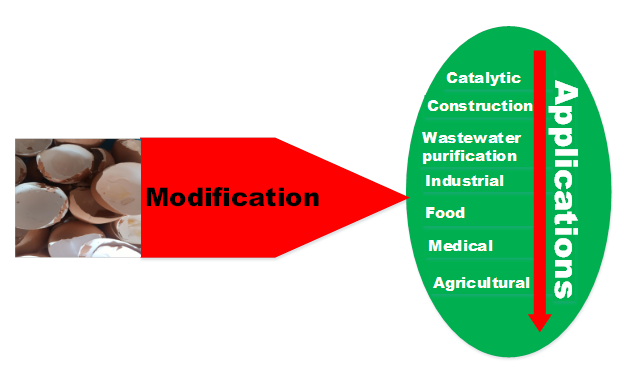 Open Access
Open Access
REVIEW
Pathways for Sustainable Utilization of Waste Chicken Eggshell
1
Department of Mechanical and Industrial Engineering Technology, University of Johannesburg, Johannesburg, South Africa
2
African Centre of Excellence, ACESPED University of Nigeria, Nsukka, Nigeria
3
Faculty of Engineering and the Built Environment, University of Johannesburg, Johannesburg, South Africa
* Corresponding Author: Omojola Awogbemi. Email:
(This article belongs to the Special Issue: Renewable Material from Agricultural Waste and By-Product and Its Applications)
Journal of Renewable Materials 2022, 10(8), 2217-2246. https://doi.org/10.32604/jrm.2022.019152
Received 06 September 2021; Accepted 04 November 2021; Issue published 25 April 2022
Abstract
Chicken eggshell is one of the most common wastes generated from households, restaurants and other food processing outlets. Waste Chicken Eggshells (WCES) also constitutes an environmental nuisance and ends up discarded at dumping site with no consideration of further usage. The main constituent of WCES is calcium carbonate from which calcium or calcium oxide can be extracted for various applications. This current effort reviews recently published literature on the diverse applications of WCES. The considered utilization avenues include catalysts for biofuel production, construction industry, wastewater purification, industrial sector, food industry, medical, and agricultural applications. The specific areas of application apart from the transesterification reactions include cement additives and replacement in concrete, asphalt binder, adsorbent of metals and dyes, production of hydroxyapatite, food supplement and fortification, dentistry, therapeutics, bone formation, drug delivery, poultry feeds as well as organic fertilizer. For most of the identified applications, the WCES is subjected to pretreatment and other modification techniques before utilization. The conversion of WCES to valuable products is a cost-effective, safe, environmentally friendly, non-toxic and viable means of waste disposal and utilization. More investigations are needed to further explore the benefits derivable from this bioresource.Graphic Abstract

Keywords
Cite This Article
 Copyright © 2022 The Author(s). Published by Tech Science Press.
Copyright © 2022 The Author(s). Published by Tech Science Press.This work is licensed under a Creative Commons Attribution 4.0 International License , which permits unrestricted use, distribution, and reproduction in any medium, provided the original work is properly cited.


 Submit a Paper
Submit a Paper Propose a Special lssue
Propose a Special lssue View Full Text
View Full Text Download PDF
Download PDF Downloads
Downloads
 Citation Tools
Citation Tools
